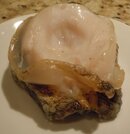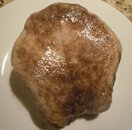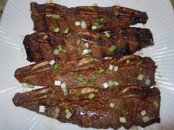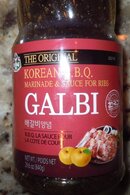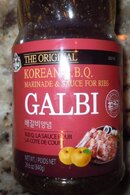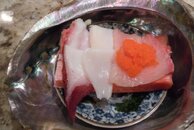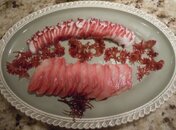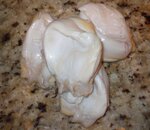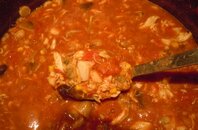- Messages
- 7,659
- Reaction score
- 4,720
- # of dives
- 200 - 499
Serious progress here...
My Asian grocery store got a bunch more abalone in recently. Same size, exactly same weight as above. Those abalones have to be farmed somewhere, they are all the same!
So, I have the luxury of practicing! OK, first off, I'll admit that I've discovered that I'm no expert on trimming them. Tried simmering until firm in lightly salted water. Interesting. Flavor is nice but really needs something. Worse yet, there still remain all sorts of tough stuff stuck (that I didn't cut off) to the lovely meat. But, at least now I know why people eat abalone!
Good taste, but needs something that is a bit richer. Bone soup. Never really liked the stuff, but it has a haunting taste. So I made the real stuff. Beef marrow bones simmered for three days. Yep, three days. Use distilled water to keep topping it up or you will concentrate all the junk in your drinking water. First day, exactly what you would expect. Why am I doing this? About to quit when something interesting happens half way into the second day. It starts to turn milky. Third day it is done. Put the pot into the refrigerator and then throw out all the fat. Reheat. Strain through a coffee filter supported in a small strainer. Twice. Done.
Simmer abalone in this and you get both tastes, very nice. The firmed up abalone clearly shows what I missed when trimming. The tough stuff turns yellowish in contrast to the snow white meat. Now easy to finish the trimming job. This could be a great dish. Working on a lightly spicy abalone and crab soup. Chunk crabmeat from a can, the real deal would overwhelm the delicate abalone taste.
The other abalone offering will be slices that were simmered just enough to go tender in bone broth. So easy to ruin abalone by overcooking. Forget raw, don't know the country of origin, don't trust it as sushi.
More to come...
My Asian grocery store got a bunch more abalone in recently. Same size, exactly same weight as above. Those abalones have to be farmed somewhere, they are all the same!
So, I have the luxury of practicing! OK, first off, I'll admit that I've discovered that I'm no expert on trimming them. Tried simmering until firm in lightly salted water. Interesting. Flavor is nice but really needs something. Worse yet, there still remain all sorts of tough stuff stuck (that I didn't cut off) to the lovely meat. But, at least now I know why people eat abalone!
Good taste, but needs something that is a bit richer. Bone soup. Never really liked the stuff, but it has a haunting taste. So I made the real stuff. Beef marrow bones simmered for three days. Yep, three days. Use distilled water to keep topping it up or you will concentrate all the junk in your drinking water. First day, exactly what you would expect. Why am I doing this? About to quit when something interesting happens half way into the second day. It starts to turn milky. Third day it is done. Put the pot into the refrigerator and then throw out all the fat. Reheat. Strain through a coffee filter supported in a small strainer. Twice. Done.
Simmer abalone in this and you get both tastes, very nice. The firmed up abalone clearly shows what I missed when trimming. The tough stuff turns yellowish in contrast to the snow white meat. Now easy to finish the trimming job. This could be a great dish. Working on a lightly spicy abalone and crab soup. Chunk crabmeat from a can, the real deal would overwhelm the delicate abalone taste.
The other abalone offering will be slices that were simmered just enough to go tender in bone broth. So easy to ruin abalone by overcooking. Forget raw, don't know the country of origin, don't trust it as sushi.
More to come...



